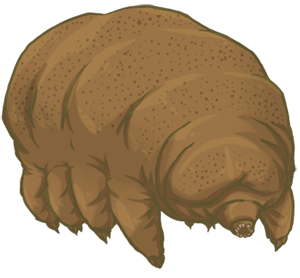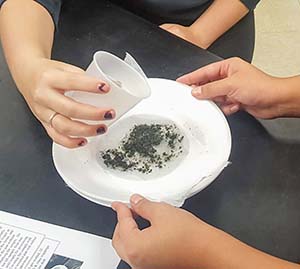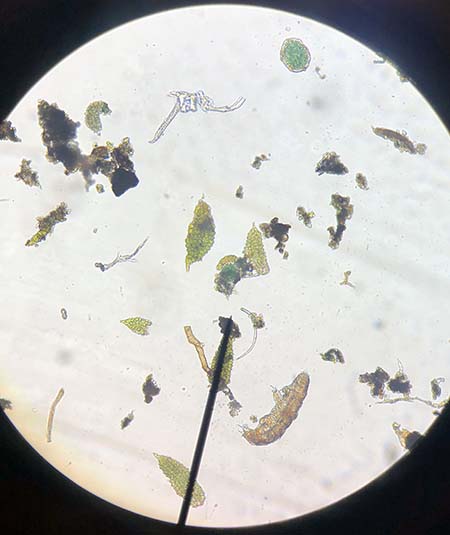 The Tardigrade Project
The Tardigrade Project
Tardigrades belong to the Animal Kingdom in the phylum tardigrada. They are small, multicellular heterotrophs that are found almost everywhere in the world, hiding almost in plain sight. They are small creatures, measuring about 1.5 mm (1500 micrometers) in length
They have a unique ability to survive extreme conditions by shedding all of the water and curling up into a structure called a "tun." Tardigrades have even been known to survive in space! In this project, you will collect tardigrades from the environment and view them with a microscope, collect data and complete a project about tardigrades.
Collecting Your Tardigrades
Tardigrades can be collected from lichens growing on trees. Lichens will appear as green or white masses on the bark of a tree. Lichens are actually a symbiotic relationship between algae and fungus and they can serve as a habitat for many microorganisms, including tardigrades.

Using a scalpel or other tool (paint scraper, butter knife, screwdriver) to scrape lichens from the tree. You do not want the entire layer of bark, just the part that has the lichens.
Store your samples in a paper bag. You may want to get multiple samples from different areas, using the bag to label each location and describe the appearance of the lichen. This may be important information if your experimental question relates to where tardigrades are located.
Before collecting and investigating tardigrades, first complete the tardigrade research assignment to help you learn more about these animals.
Filtering Tardigrades Using Baermann Pans
Baermann pans can be constructed from foam dinner plates, tulle and staples. The general idea is that two plates are sandwiched, and a sample is placed over the mesh screen (tulle) where the microorganisms will fall down into the pan below. This method works for collecting microorganisms like nematodes, rotifers, amoebas, and tardigrades.
1. Cut a hole in one plate and cover it with a nylon mesh or tulle. Staple to hold the mesh into place. You can also opt to trim away any of the loose mesh. *These may have been made for you already.
2. Lay a thin (single ply) tissue over the screen.
3. Place the plate with mesh over another plate that does not have mesh (like a sandwich).
4. Place your sample of lichens over the mesh and pour a generous amount of distilled water over the top. This water will filter to the plate below and over the course of 12-24 hours, microorganisms will also move into the lower pan.
5. Your teacher may check your pans in a couple of hours, if there is very little water, more will be added, the tissue should stay moist. Placing another plate over the top one may reduce evaporation.
6. DO NOT DISTURB the pans.
-------------------------------------- 24 Hours Later ----------------------------------
1. Lift the sample and tilt into the lower plate to speed drainage.
2. Carefully pour the water from the lower plater into a beaker (or cup)
3. Use distilled water to rinse the plate, many microorganisms will cling to the bottom. You want to wash them into the beaker.
4. Use a pipette to draw water from the bottom of the beaker where more of your microorganisms will be located. Place in a petri dish and use a dissecting scope to scan the sample for evidence of life.
5. Be patient, tardigrades are easily overlooked! You may also find small worms called nematodes, rotifers, and other living things in your sample.
6. If you can find one using the dissecting scope, the pipette can be used to carefully transfer it to a microscope slide and view at a higher power. Do not use coverslips (you’ll smush your tardigrade!) and only view with the scanning (40x) and low power objective (100x).
Things to do with your Tardigrades - Your Project
Hopefully you have found a tardigrade and maybe even other living organisms in your sample. Choose ONE of the following tasks to gather data and prepare a report, photo, or video.
1. Consider your experimental question from your research project. Use your tardigrades to answer the question and write a report. *This might be difficult giving constraints of laboratory equipment and time.
2. Compare locations and samples. If you didn’t find tardigrades in your sample, check out other groups and gather evidence about differences between sampling and filtering techniques. Write your report on the best way to get tardigrades.
3. Expose your tardigrade to different environments and observe its behavior. Does it respond to light? Does it respond to other tardigrades? Write a report that summarizes the observed behaviors of the tardigrade.
4. Take a photo of your tardigrade and label any anatomical features you can with captions about their functions. Share this with the class.
5. Take a video of your tardigrade and narrate it with “fun facts” about tardigrades. Share this with the class.
Other Resources
Notes: Beginning collectors may have a difficult time finding tardigrades. The suggested projects take into account that some groups may not find any organisms in their sample. I do not recommend this project for freshman, their microscope skills (and patience) just aren’t that good at that age level. I did this project with a senior level AP Biology class.
Tardigrade Beginning Research - a set of questions for students to answer as a pre-lab or introduction to the project
Complete guide to Baermann Pans - pdf file with some additional instructions and tips
Southern Illinois Tardigrada - lesson plans and other resources related to tardigrades. Also has a information an taxonomy and how to determine tardigrade species.
Videos
https://www.youtube.com/watch?v=wIVk-SJFxCQ - Tardigrade in space on Nat Geo TV
https://www.youtube.com/watch?v=7W194GQ6fHI - First Animal to Survive in Space
https://www.youtube.com/watch?v=EMTRNNaXVmg - Water Bears Aren’t as Cute as the Internet Thinks
https://www.youtube.com/watch?v=aHsVyb_VfeA - Water Bears in HD
https://www.youtube.com/watch?v=cjV2WP0wkvo - Tardigrade Facts
Tardigrades Explained (article): https://www.vox.com/science-and-health/2018/2/8/16991280/tardigrade-facts-waterbear-explained
Tardigrade Sex Does Not Disappoint - article plus video at mentalfloss
How to Find Tardigrades - Microcosmos - This site provides extensive photos and suggestions for lichen collection and an alternative way to filter microorganisms (we used the baermann pan technique).
https://microcosmos.foldscope.com/?p=17901
Photo of a Tardigrade at 100x, image credit: Alex Hutson, Class of 2019


